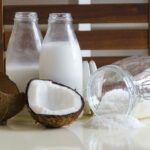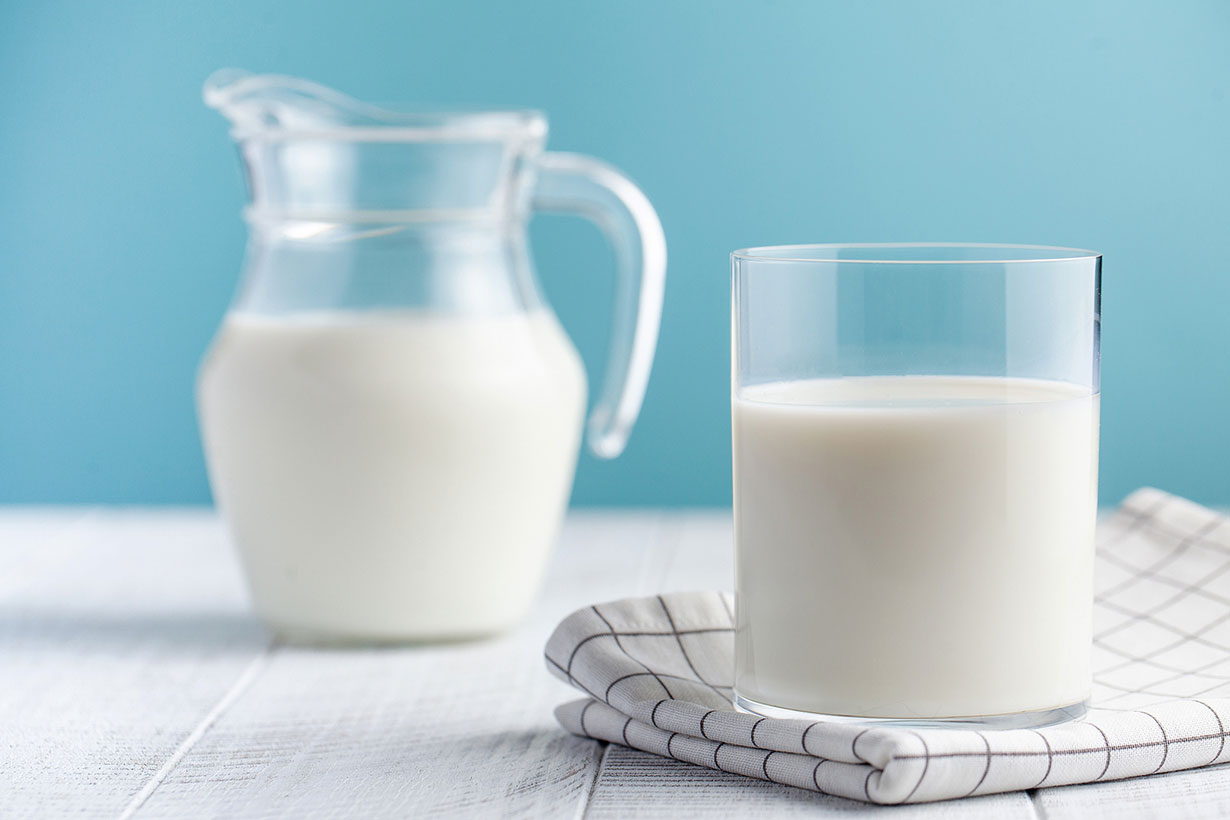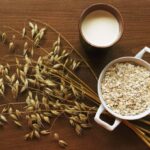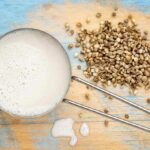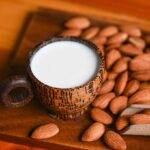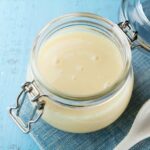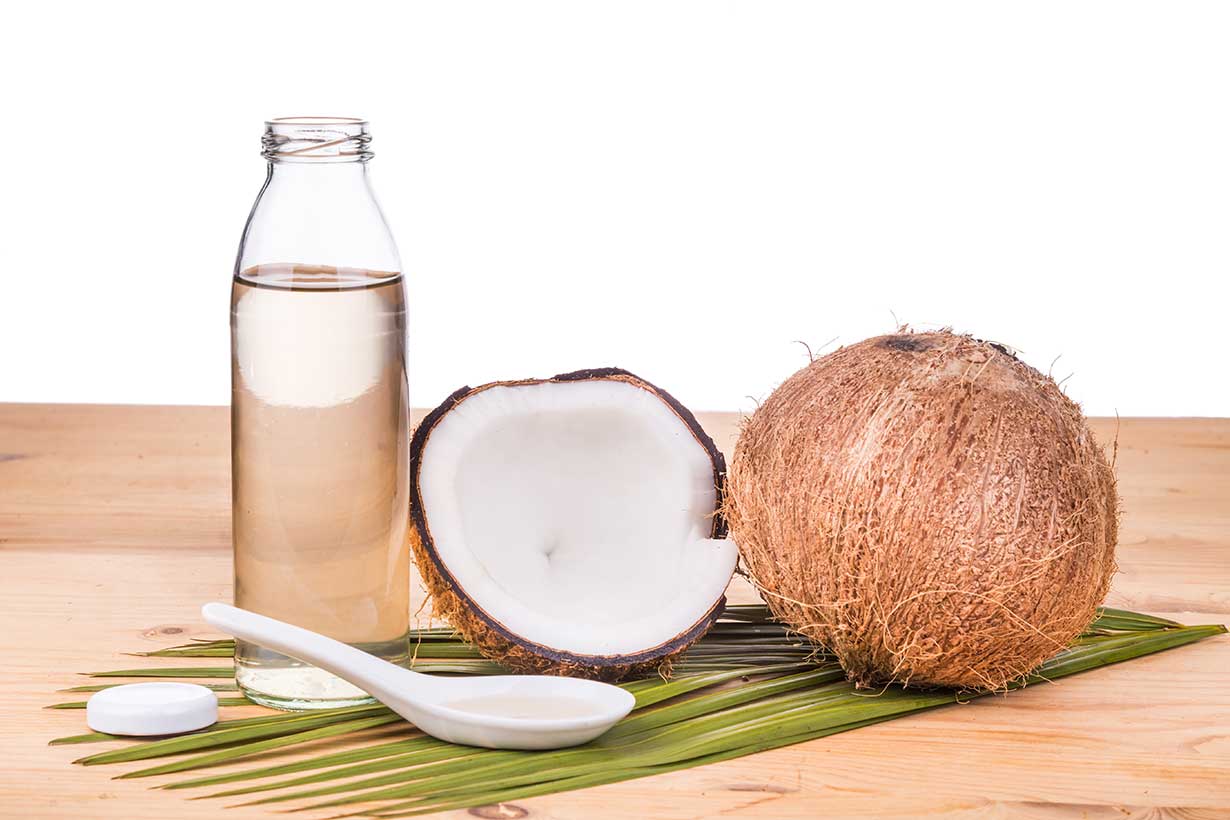Coconut milk is a plant-based ‘milk’ option that enjoys popularity worldwide.
It tastes great and is an ingredient in a wide variety of dishes.
However, what does coconut milk offer nutritionally? And is it a healthy choice?
This article examines scientific research on coconut milk alongside its complete nutritional profile.
Table of contents
What Is Coconut Milk?
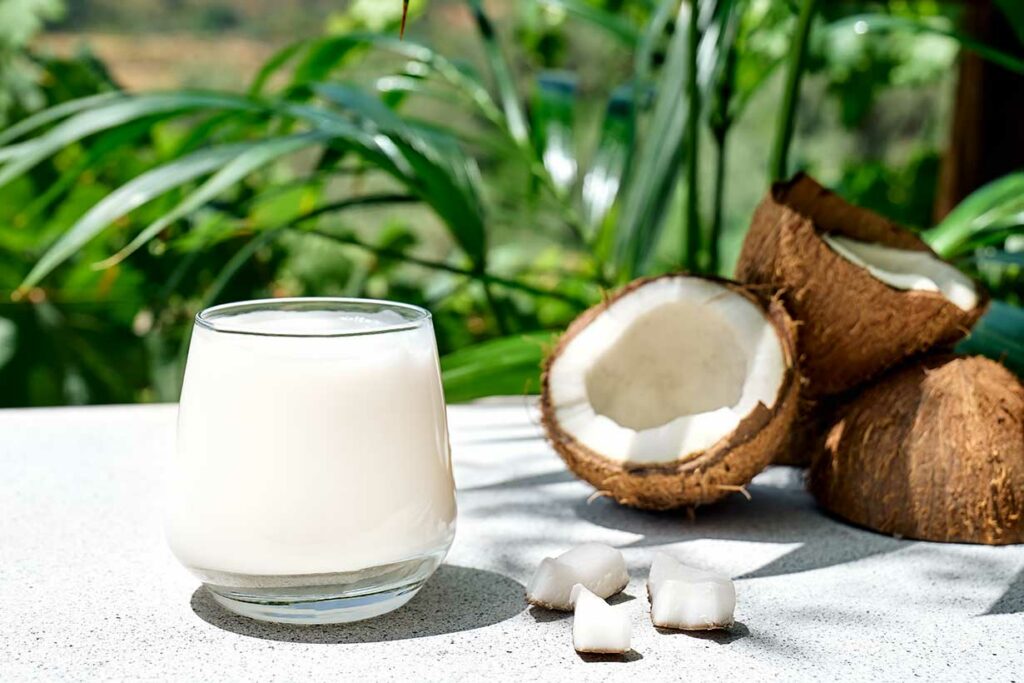
Coconut milk has the appearance of a white liquid ‘milk’ and it is a coconut product made by mixing grated coconut flesh with water.
Most commercially available coconut milk contains a mix of two or three simple ingredients: coconut milk, water, and possibly guar gum (a thickener).
In terms of appearance, the liquid resembles milk, and some people use (the light variety) as a replacement for dairy milk in drinks.
Regular coconut milk usually features in cooked dishes for flavoring and texture purposes.
Coconut milk is popular as an ingredient in curries and stews and features extensively in Indian and South-East Asian cuisine.
This extensive list of dishes made using coconut milk provides more information on its culinary uses.
Most commercial coconut milk production occurs in tropical regions from freshly harvested coconuts. The major producers and exporters include Indonesia, Sri Lanka, Thailand, and the Philippines (1).
How Is Coconut Milk Made?
The commercial production of coconut milk is quite a simple process. Here is a summary:
- Firstly, coconut water is extracted from the coconut.
- The shells of the coconut are then removed.
- After this, the coconut meat is submerged in hot water to soften it.
- After removing imperfections, the coconut meat is cut into smaller pieces and grated into flakes.
- These coconut flakes then go into a mechanical screw press machine to extract coconut milk.
- Once extracted, the coconut milk goes through a heating process to pasteurize the milk.
- Lastly, coconut milk is homogenized and sterilized to ensure a consistent texture and kill bacteria.
An informative video details the whole process in more detail here.
Nutrition Facts
Nutritionally, the main components of coconut milk are water and fat.
Here you can find the total nutritional values for regular coconut milk per 15-gram tablespoon serving.
The source for nutritional data is the USDA’s FoodData Central database. Daily values have been calculated using USDA data and the recommended daily values from the FDA (2, 3).
| Name | Amount | % Daily Value (% DV) |
|---|---|---|
| Calories | 34.5 kcal | |
| Carbohydrates | 0.83 g | 0.3% DV |
| Fiber | 0.33 g | 1.2% DV |
| Sugars | 0.50 g | |
| Fat | 3.57 g | 4.6% DV |
| Saturated | 3.16 g | 11.3% DV |
| Monounsaturated | 0.15 g | |
| Polyunsaturated | 0.04 g | |
| Omega-3 | – | |
| Omega-6 | 0.04 g | |
| Protein | 0.34 g | 0.7% DV |
| Cholesterol | 0 g | |
| Water content | 10.1 g |
Vitamins
- Niacin (B3): 0.7% DV
- Pantothenic acid (B5): 0.6% DV
- Folate: 0.6% DV
- Vitamin C: 0.5% DV
- Thiamin (B1): 0.33% DV
- Vitamin B6: 0.3% DV
- Choline: 0.2% DV
- Vitamin E: 0.1% DV
- Vitamin K: <0.1% DV
Minerals
- Manganese: 6.1% DV
- Copper: 4.4% DV
- Selenium: 1.7% DV
- Iron: 1.4% DV
- Magnesium: 1.3% DV
- Phosphorus: 1.2% DV
- Zinc: 0.9% DV
- Potassium: 0.8% DV
- Calcium: 0.2% DV
- Sodium: 0.1% DV
Phytonutrients
In addition to its vitamin and mineral content, coconut milk contains some phytonutrients.
Phytonutrients, such as polyphenols, are bioactive chemicals found in plants that can affect the body (4).
According to research published in the International Journal of Food Science in August 2020, commercially available coconut milk contains the following polyphenolic compounds per 100 ml (5):
- Gallic acid: 1.01 mcg
- Chlorogenic acid: 0.94 mcg
- Para-hydroxybenzoic acid: 0.08 mcg
- Caffeic acid: 0.59 mcg
- Vanillic acid: 0.61 mcg
- Syringic acid: 1.11 mcg
- Ferulic acid: 0.38 mcg
Potential Benefits of Coconut Milk
Coconut milk may have several benefits owing to its nutritional and culinary properties.
Light Coconut Milk Is a Non-Dairy Milk Substitute
When visiting a popular coffee shop chain, it is common to see a non-dairy ‘coconut milk’ option.
Light coconut milk provides a smooth and creamy texture to drinks and does not contain lactose (milk sugar).
For this reason, coconut milk is a good dairy substitute for individuals with lactose intolerance or a vegan dietary preference.
However, it is worth pointing out that coconut milk is not the nutritional equivalent of dairy milk.
A Good Source of Minerals
People tend to consume coconut milk in relatively small serving sizes, so it is challenging to consume large amounts of nutrients from it.
However, gram-for-gram, coconut milk is a good source of essential minerals.
For instance, just a tablespoon (15g) serving of coconut milk provides more than 1% of the recommended daily value for six minerals. Among these minerals, a tablespoon supplies more than 6% of the recommended daily value for manganese and more than 4% of the daily value for copper (2, 3).
That said, coconut products that contain more coconut meat, such as coconut butter, are a more concentrated source of minerals.
Potential Gastroprotective Properties (Weak Evidence)
A small 2017 study involving 45 Wistar rats examined the ability of coconut milk to prevent damage and heal from 95% ethanol-induced gastric ulcers (6).
In the study, rats with induced gastric ulcers appeared to suffer less inflammation and recover quicker when fed with coconut milk than a control (no treatment) and saline water (sham treatment) group.
Additionally, the rats fed coconut milk showed progressive healing over seven days at a significantly increased rate compared to the control group. The healing rate approached a level seen in rats administered with omeprazole, a known anti-ulcer drug.
Previous research also demonstrated that feeding coconut milk to rats with induced ulcers led to a more substantial and quicker reduction in ulcer area size (7).
These studies suggest coconut milk may have some gastroprotective properties. However, it is important not to take findings from small animal studies to imply the effect would be the same in humans.
In other words, more research in this area is necessary before making firm conclusions.
Potential Downsides
As well as having benefits, coconut milk may also have downsides. Here is a quick summary of these potential drawbacks.
Very High In Saturated Fat
Coconut milk is a significant source of saturated fat, with a tablespoon (15g) serving providing 3.16 grams. This level of saturated fat is equivalent to 21.1 grams on a per-100-gram-basis (2).
High intake of saturated fatty acids can cause elevations in LDL cholesterol (LDL-C), which strongly correlates with an increased risk of cardiovascular disease (8, 9).
Currently, limited research exists on the effect of coconut milk on blood cholesterol levels.
However, a 2013 study examined the effects of consuming coconut milk on LDL-C levels in sixty healthy adults (10).
Interestingly, the results of this study were not as expected. Instead, the study demonstrated that giving the participants coconut milk porridge (fat content: 23g) five days a week for eight weeks led to a significant fall in LDL-C levels compared to baseline (133.9 mg/dL to 119.0 mg/dL).
During an eight-week washout after the coconut porridge intervention, the participants’ LDL-C levels rose to 139.3 mg/dL.
Following this, providing the participants with soy milk porridge five days per week for eight weeks led to LDL-C levels falling (but less significantly than in the coconut porridge group) from 139.3 mg/dL to 127.5 mg/dL.
Interpreting The Findings
The study’s authors stated that the saturated fat content of coconut milk could not explain their study’s findings. Further, they speculated that other components of coconut milk, such as soluble fiber, may have influenced the unexpected effect it had on LDL in their study.
This is just one study, and more extensive and rigorous research is necessary to better understand coconut milk’s impact on LDL-C before concluding.
However, until then, caution should be warranted.
Multiple human trials have demonstrated that coconut oil—which has the same fatty acid content as coconut milk—can significantly raise LDL-C (11, 12, 13).
If looking for a milk option with lower saturated fat, other plant milk options such as almond milk and oat milk, as well as skim dairy milk, are good alternatives.
Coconut Milk Is Very High In Calories
All high-calorie foods can fit into a good overall diet when consumed appropriately.
However, high-calorie foods such as coconut milk tend to be easier to over-consume.
With just one tablespoon providing 34.5 calories, a 240-ml cup portion of coconut milk contains a substantial 552 calories (2).
Coconut Allergy
Although rare, coconut allergy can have potentially serious consequences.
On this note, a 2021 retrospective review analyzed 275 records of patients showing coconut sensitivity at an allergy center in Chicago between 2002 and 2017 (14).
The review found that:
- Among the 275 patients, sixty-nine experienced allergic reactions to coconut.
- Fifty-seven of the allergic reactions were from oral ingestion of coconut.
- Approximately 50% of the allergic reactions from oral ingestion resulted in mild to moderate anaphylaxis. Anaphylaxis is a severe allergic reaction that can sometimes lead to unconsciousness or even death (15).
For this reason, any individual who suspects they may have an allergy to coconut should consult their medical team before consuming coconut milk.
Different Types of Coconut Milk
While this article has focused on regular coconut milk, it is important to note that several coconut milk varieties exist.
The main difference between these coconut milk varieties is their fat content, and they include:
- Coconut cream (highest fat content, primarily used in cooking)
- Regular coconut milk (mostly used in cooking)
- Light coconut milk (lowest fat content due to extra added water)
In the table below, based on USDA data, we can see the basic calorie and macronutrient composition of these coconut milk options per 100 grams (2, 16, 17):
| Name | Coconut Milk | Coconut Cream | Light Coconut Milk |
|---|---|---|---|
| Calories | 230 kcal | 330 kcal | 57 kcal |
| Carbohydrates | 5.54 g | 6.65 g | 1.27 g |
| Fat | 23.8 g | 34.7 g | 5.7 g |
| Saturated | 21.1 g | 30.8 g | 5.06 g |
| Protein | 2.29 g | 3.63 g | 1.27 g |
The nutritional data shows that light coconut milk is much lower in carbohydrates, fat, and total calories.
As a result, it is far more suitable in larger serving sizes and for use in drinks compared to regular coconut milk.
Regarding coconut cream, it contains significantly more fat than regular coconut milk.
The most common usage for coconut cream is using small amounts to thicken and flavor cooked dishes such as curry.
Is Coconut Milk Nutritionally Similar To Dairy Milk?
As mentioned earlier in the article, coconut milk is not the nutritional equivalent of regular dairy milk.
For example, light coconut milk, used in drinks, has 1.27 grams of protein per 100 ml (17).
In contrast, whole milk has 3.3 grams of protein per 100 ml, and skim milk provides 3.6 grams (18, 19).
Furthermore, dairy milk is an excellent dietary source of calcium, whereas coconut milk has minimal calcium content.
In summary, dairy and coconut milk’s nutritional content is somewhat different.
While the two are interchangeable based on preferences, this is not the case based on nutritional values.
How To Use Coconut Milk
Here are some common ways to use coconut milk.
Coconut Milk/Cream
- Add a small amount to curries, soups, and stews for flavor and as a thickener
- As a cream replacement in coffee or hot chocolate
- To thicken smoothies or milkshakes
Light Coconut Milk
- As a base for a soup
- A dairy replacement in drinks such as cafe latte
- As a base for soups and milkshakes
Final Thoughts: Is Coconut Milk a Healthy Choice?
Coconut milk is a tasty and versatile ingredient, providing a good source of fiber and several minerals.
However, it is also relatively high in calories and saturated fat.
Coconut milk can fit into an overall healthy diet, but it is probably better to moderate its use and stick to recommended serving sizes.

